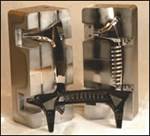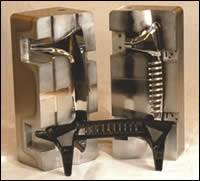“Top Secret”: How to Protect Your Mold: Top Finish, Dims and Integrity
Mold coating challenges and solutions for those working within the aerospace industry.
Interestingly, many products we use in our every day lives were originally developed
for use in once advanced NASA space programs or other “top secret” projects that now seem almost commonplace.
This also holds true for coatings frequently used in the tooling industry. Take Nickel-PTFE, for example. This very popular mold coating was originally developed for use by NASA to facilitate grease-free lubricity in space applications, such as the robot used for collecting rocks on the moon or Mars.
How was it first developed? The Teflon® particles carry an ion charge to attract them to the part of the mold to be plated. The tricky part of this chemistry is preventing the particles you want co-deposited from plating themselves and also keeping them in full suspension in the plating bath instead of on the bottom of the plating tank. Once researchers figured out the formula for this dispersion, other particles such as diamond and boron nitride became much easier to develop.
Like Nickel-PTFE, nickel boron nitride was developed several years ago for more advanced applications in manufacturing. It provided more lubricity with higher hardness benefits in high temperature applications. While this co-deposition was developed for very specific, high-end manufacturing purposes, now moldmakers building molds in all industries look to this coating and its benefits.
Strict process control when using each of these coatings is developed and monitored by such organizations as NADCAP, MillSpec, AESF and ISO.
Some Aerospace and Other Applications
Fighter pilot face shield helmet lens
The critical factor here was to ensure perfect visibility through the face shield, so the mold required an A-1 Diamond finish. Generally for parts such as this no coating would be needed, partly due to the fact that it made for easier touch-ups during maintenance checks.
Jet plane joy stick control
This control is ergonomically designed with buttons and intricate detail, and in this case was for an F-18 fighter jet. The customer had a problem with the material sticking on the sections of the mold where it was textured. The grip was stippled. A Nickel-PTFE coating was applied and the problem was solved.
Gun components
Plating is beneficial on firearm components such as barrels, receivers, shotgun parts and scat guns. Nickel-PTFE and boron nitride is most often applied because it offers excellent lubricity. Chrome plating on specific components for abrasion protection also is applied.
Bomb and missile components
Both polishing and plating for molds that form nose cones for missiles or bombs can be done. To provide abrasion resistance, the mold is polished to a lens quality finish and hard chrome is applied.
Detonation devices
A mold that manufactured detonation pins for a type of land mine was given a combination of Nickel-PTFE and an A-1 diamond polish, which provided a more efficiently molded, flawless pin.
Tank components
A tank first used in the Iraq War (Desert Storm) had a problem with sucking sand into its air intake and the sand would clog everything up. The military developed a device that would spin to get rid of the sand and prevent more from getting into the intake mechanism. The device was small and had fan-like blades as part of the filter—a helix blade fan. It made a slight twist on ejection from the mold cavity, requiring an application of Nickel-PTFE to aid in release.
New and Aggressive Molding Compounds
Today, we are further challenged by new abrasive and/or corrosive molding compounds that are used today. We’re talking about high impact materials such as glass- or mineral-filled, which are most prevalent today. An electroless nickel base plating is excellent for corrosion protection, however, when molding an abrasive material, hard chrome or diamond-chrome will give the ultimate protection.
Summary
When it comes down to it, the reason for using sophisticated, advanced coatings in aerospace applications is much the same as for medical, pharmaceutical, packaging or other high-end tooling applications: to protect the mold and its surface finish, dimensions and integrity. Bottom line, it serves to protect a very valuable investment.
Related Content
Surface Finish: Understanding Mold Surface Lingo
The correlation between the units of measure used to define mold surfaces is a commonly raised question. This article will lay these units of measure side by side in a conversion format so that companies can confidently understand with what they are dealing.
Read MoreThe In's and Out's of Ballbar Calibration
This machine tool diagnostic device allows the detection of errors noticeable only while machine tools are in motion.
Read MoreHow to Use Thermal Management to Improve Mold Cooling
A review of common mold cooling issues and possible solutions, including 3D printing applications.
Read MoreRead Next
How Surface Treatments Keep Molds Operating Longer
Important tips and information about mold coatings to help you achieve the level of production that you and your customers desire.
Read MoreCoatings and Finishes for Electrical and Electronics Molding
Electrical and electronic components take many forms and functions and require special attention when considering surface treatment options.
Read More












.jpg;maxWidth=300;quality=90)










